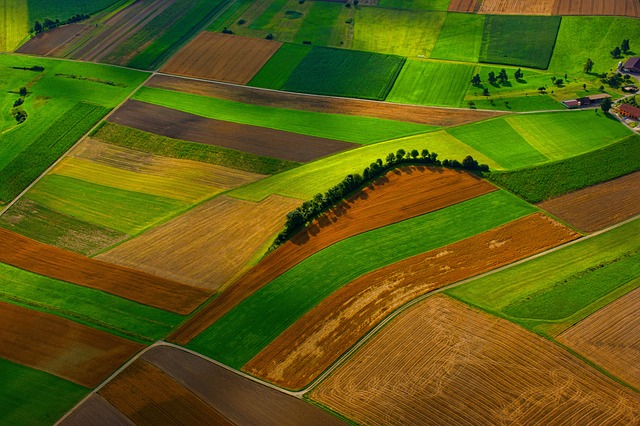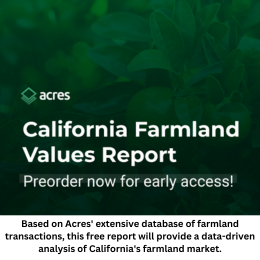March 14, 2023
By Ben Palen, Ag Management Partners
In July, 2021, I penned an article regarding the farmland market, and expressed the opinion that it reminded me in some respects of a term that was used in the 1990s by the then Chairman of the Fed, Alan Greenspan. That term was “irrational exuberance.” In the past handful of years, low interest rates, coupled with what can be described as a commodity super cycle, large government payments pertaining to COVID relief programs, along with large amounts of investor capital flowing into the market, have combined to create an environment that, to me, is reminiscent of some of the housing bubbles that we have experienced in the U.S., most recently in the late 2000s.
In April, 2022, I updated my 2021 article. In that period of time, the cost of long-term, fixed rate money to buy farmland had risen from the mid 4s to the mid to high 6s; the war in Ukraine had begun to cause lots of disruption in world markets, and—go figure—the land market was still booming, notwithstanding an environment of high cost crop inputs and shortages of some inputs.
What has changed since then? The answers to that question are not completely rooted in hard data, and one cannot ignore such big picture concerns as:
~ Long term rates that are now in the 8 percent neighborhood.
~ Continued high input costs.
~ The declining population growth in the world’s largest importer of grains (China).
~ The demonstrable effects of climate change.
~ The increased uncertainty about consequences of a prolonged war in Ukraine.
Some of the noted items can rightly be described as existential threats to agriculture.
Those answers are, in some significant measure, tied to impressions gained from a lifetime in agriculture and from discussions with some of my peers who have lived through many cycles in this business. Call them gut feelings, if you will, but they still carry great weight with most thoughtful people in this data-driven world in which we live. As one of my peers said—not all of the answers are on a spreadsheet.
If one looks back over the past five years, many proponents of farmland investment made a strong point about the projected world population in the middle of this century, and the need for increased production from farms in order to feed those mouths. It seems almost remarkable that, particularly in the past few months, we have seen some thoughtful writing about China’s declining population. There are suggestions by some that similar trends will surface in other parts of the world.
Also, and again referencing a look back over the past few years, climate change, while not ignored as a concern, has become more apparent as we see massive weather events—floods, prolonged heat, etc.—become part of regular headlines.
Further, there has been explosive growth in the amount of “non-farmer capital” that has come into the agricultural land markets, notably in the U.S. and in parts of Europe. Some of us recall those times in the 1980s and 1990s when the notion of outside capital was anathema to many in the agricultural sector. When I wrote the July 2021 article, I referred to farmland becoming the “investment du jour” for some people. That was not meant to come across as cynical, but rather to address the massive amounts of new capital that had come into the market in the last few years. While it is undeniable that a large amount of that capital was thoughtfully placed, there are most certainly instances where the pressure to deploy capital, and a lack of deep knowledge of the nuances of the ag world, have led to some bad investment decisions. In the current environment, one has to wonder how much of that non-farmer capital might be called “fair weather capital,” or whether it reflects a long-term investment trend.
In the course of doing research for this article, I spoke with farmers whose families have tended their land for generations, along with some seasoned land investment professionals, and a few newer entrants into the market. I have also reflected on my experiences over the past four decades, and especially over the past five years or so with regard to land investment. As noted earlier, not all of the answers are going to be found on a spreadsheet. Instead, they are rooted in attitudes and perceptions that reflect some historical perspectives on agriculture along with concerns about the so-called existential threats to those of us who produce the world’s food.
Considering the above factors, I believe that it is fair to say that a yellow light is blinking over the farmland market. That is not to say that sound deals are lacking. But it must also be said that headlines about someone paying $30,000 an acre for 80 acres of land are not in any way truly reflective of where we stand today, nor where we are headed for the farmland market as a whole. We have gone through a commodity super cycle, and other major disruptions, many of which would have been difficult to foresee, and it is hard to imagine any scenarios other than a correction in land values. It is already underway in many places. There are some obvious analogies that, when interest rates rise, asset values fall. And there are some that may not be so obvious, such as whether the expectations of future grain demand based on population growth are going to materialize.
On the other side of the coin, there are considerations about the increasing alternative uses of certain commodities, the shrinking amount of arable land in the world, and diminished water availability in some key growing areas. Further, the role of certain bio products in enhancing efficiency of some crop inputs—notably fertilizer—cannot be overlooked as a plus factor for agriculture.
It seems appropriate to close this article with mention of one other item that will not appear on a spreadsheet. And that is the feeling of security from owning farmland in an otherwise insecure world. I cannot put a number on that feeling. That said, there is no question that it plays a role, consciously or unconsciously, in decisions made by farmers and non-farmers about buying land. It is not all about yield.
I will plan on another update, probably around this year’s end. As with many of you, I am deeply curious about where the current trends are headed.
ABOUT THE AUTHOR:
Ben Palen is a fifth generation farmer with experience in many aspects of agriculture, including projects in the United States, Africa, and the Middle East. The focus on all projects is sustainable practices based on a mix of boots on the ground work and selected use of agtech tools.
*The content put forth by Global AgInvesting News and its parent company HighQuest Partners is intended to be used and must be used for informational purposes only. All information or other material herein is not to be construed as legal, tax, investment, financial, or other advice. Global AgInvesting and HighQuest Partners are not a fiduciary in any manner, and the reader assumes the sole responsibility of evaluating the merits and risks associated with the use of any information or other content on this site.

Let GAI News inform your engagement in the agriculture sector.
GAI News provides crucial and timely news and insight to help you stay ahead of critical agricultural trends through free delivery of two weekly newsletters, Ag Investing Weekly and AgTech Intel.




